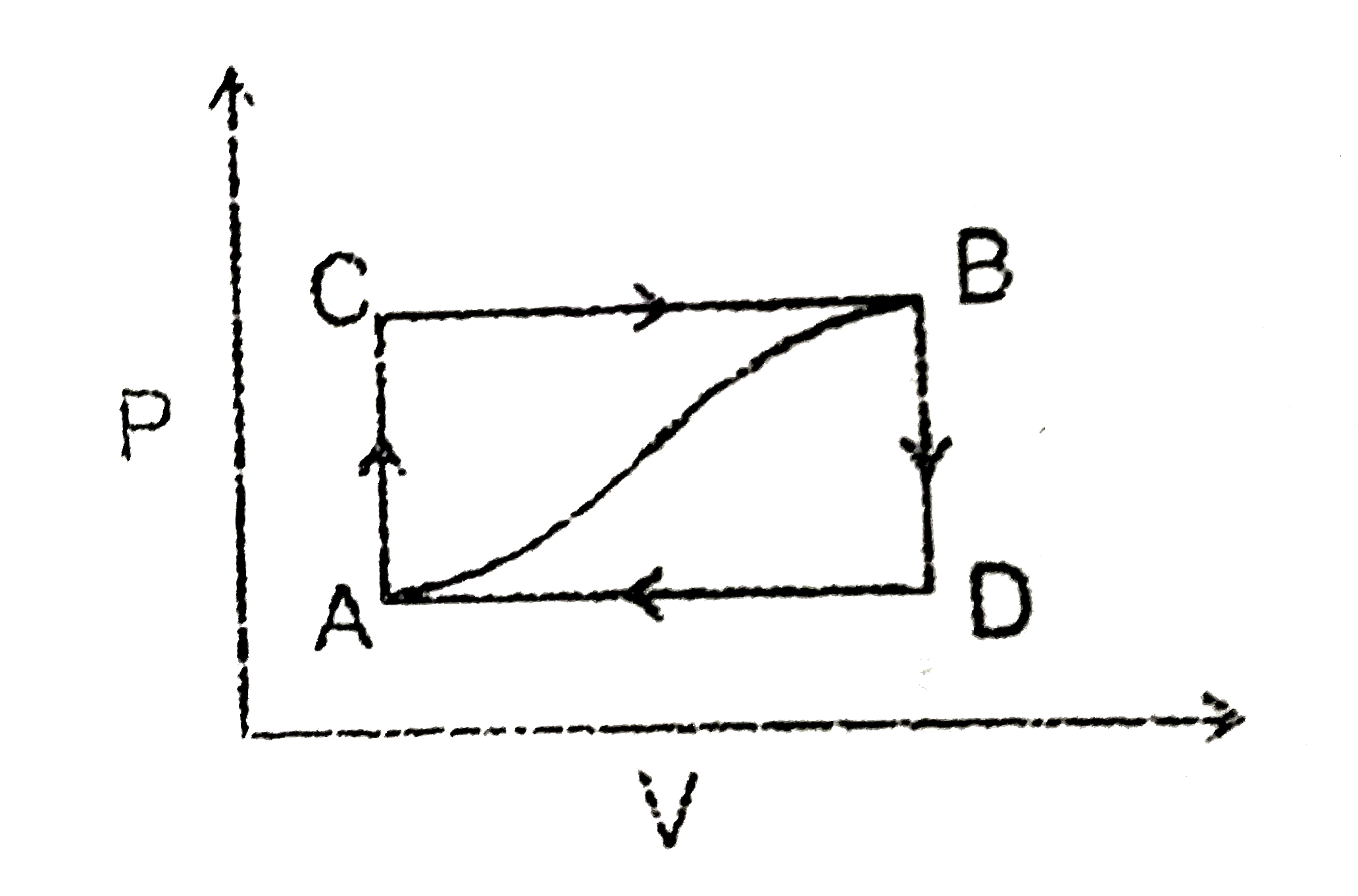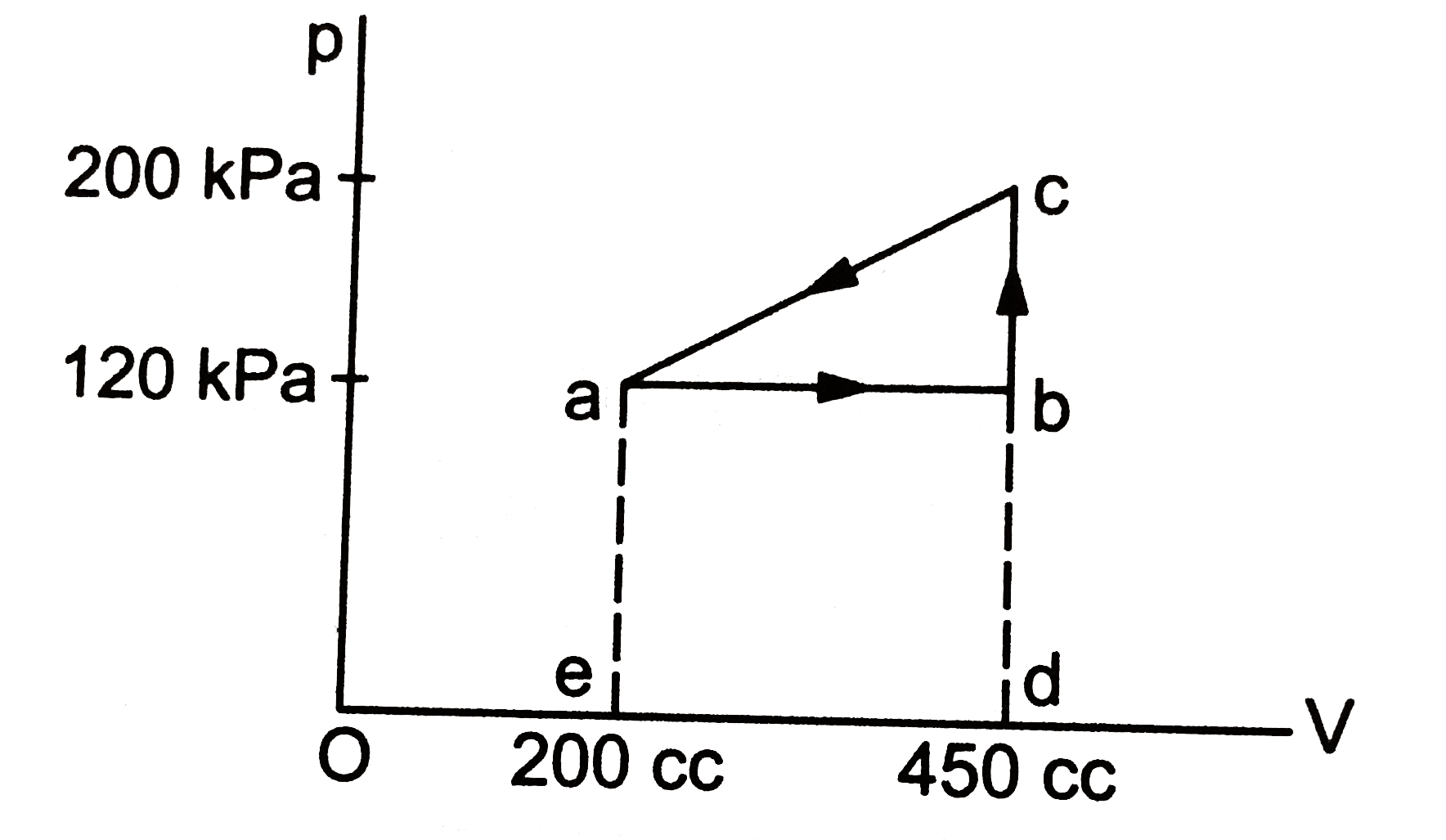When an ideal gas is taken from state a to b, along a path acb,84kJ of heat flows into the gas and the gas does 32kJ of work. The following conclusions are drawn. Mark the one which is not correct.

If the work done along the path adb is 10.5kJ, the heat will flow into the gas is 62.5kJ
When the gas is returned from b to a along the curved path, the work done on the gas is 21kJ, and the system absorbs 73kJ of heat
If Ua=0,Ud=42kJ, and the work done along the path adb is 10.5kJ then the heat absorbed in the process ad is 52.5kJ.
If Ua=0,Ud=42kJ, heat absorbed in the process db is 10kJ.
The correct Answer is:B
b. For path acb:
ΔQ=ΔU+ΔW
⇒84=ΔU+32⇒ΔU=52kJ
Hence ΔUacb=ΔUab=ΔUadb=52J
For path adb:
ΔQ=ΔU+ΔW
=52+10.5=52.5kJ
So option (a) is correct.
For process ba, system will release the heat. So option (b) is wrong.
For path ad:
ΔWadb=ΔWad+ΔWdb
⇒10.5=ΔWad+0
⇒ΔWad=10.5kJ
ΔQad=ΔUad+ΔWad
=(42−0)+10.5
=52.5kJ
So option (c ) is correct.
ΔQadb=52+10.5=62.5kJ
ΔQdb=ΔQadb−ΔQad
=62.552.5
=10kJ
So option (d) is correct.
Hence answer of this question is (b)
Topper's Solved these Questions
- KINETIC THEORY OF GASES AND FIRST LAW OF THERMODYNAMICSBOOK - CENGAGE PHYSICS ENGLISHCHAPTER - KINETIC THEORY OF GASES AND FIRST LAW OF THERMODYNAMICSEXERCISE - Multiple Corrects
29 Videos
- KINETIC THEORY OF GASES AND FIRST LAW OF THERMODYNAMICSBOOK - CENGAGE PHYSICS ENGLISHCHAPTER - KINETIC THEORY OF GASES AND FIRST LAW OF THERMODYNAMICSEXERCISE - Assertion-Reasoning
6 Videos
- KINETIC THEORY OF GASES AND FIRST LAW OF THERMODYNAMICSBOOK - CENGAGE PHYSICS ENGLISHCHAPTER - KINETIC THEORY OF GASES AND FIRST LAW OF THERMODYNAMICSEXERCISE - Subjective
22 Videos
- KINETIC THEORY OF GASESBOOK - CENGAGE PHYSICS ENGLISHCHAPTER - KINETIC THEORY OF GASESEXERCISE - Compression
2 Videos
- LINEAR AND ANGULAR SIMPLE HARMONIC MOTIONBOOK - CENGAGE PHYSICS ENGLISHCHAPTER - LINEAR AND ANGULAR SIMPLE HARMONIC MOTIONEXERCISE - Single correct anwer type
14 Videos
Similar Questions
When a system is taken from state A to state B along path ACB as shown in figure below, 80J of heat flows into the system and the system does 30J of work.

When the system is returned from state B to A along the curve path, the work done on the system is 20J.
Does the system absorb or liberate heat and by how much ?
View SolutionWhen a system is taken from state A to state B along path ACB as shown in figure below, 80J of heat flows into the system and the system does 30J of work.

How much heat flows into the system along path ADB if the work done by the system is 10J:
View Solution
Knowledge Check
An ideal gas is taken through cycle A→B→C−A, as shown in Fig. IF the net heat supplied to the gas in the cycle is 5 J, the work done by the gas in the process C→A is
 A−5JB−10JC−15JD−20J
A−5JB−10JC−15JD−20J
When a system is taken from state A to state B along path ACB as shown in figure below, 80J of heat flows into the system and the system does 30J of work.

If ED−EA=−40J, the heat absorbed in the processes AD and DB are respectively
View SolutionWhen a system is taken from state a to state b, in figure along the path a→c→b, 60J of heat flow into the system, and 30J of work is done :
(i) How much heat flows into the system along the path a→d→b if the work is 10J.
(ii) When the system is returned from b to along the curved path, the work done by the system is −20J. Does the system absorb or liberate heat, and how much ?
(iii) If , Ua=0 and Ud=22J, find the heat absorbed in the process a→d and d→b.
_S01_052_Q01.png)
View SolutionAn ideal gas change from state a to state b as shown in Fig. what is the work done by the gas in the process?

View SolutionOne mole of an ideal monoatomaic gas is taken from A to C along the path ABC . The temperature of the gas at A is T0 . For the process ABC :

View SolutionOne mole of an ideal gas is taken from a to b along two paths denoted by the solid and the dashed lines as shown In the graph below. If the work done along the solid line path is Ws and that along the the dotted line path is wd, then the integer closest to the ratio wd/ws is

View Solutioncalculate the work done by a gas as it is taken from the state a to b, b to c and c to a as shown in

View SolutionIn given figure, when a thermodynamic system is taken from state A to state B via path ACB,100 cal of heat given to the system and 60cal work is done by the gas. Along the path ADB, the work done by the gas is 20cal. Find the heat flowing into the system in this case?

View Solution
